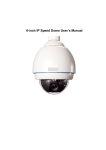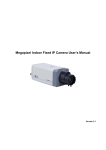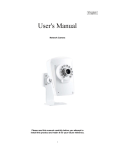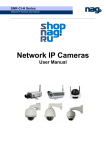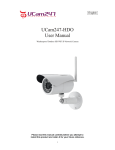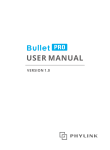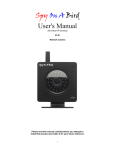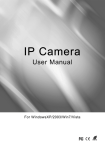Download Product Manual
Transcript
F Series Indoor IP Camera User’s Manual For F725/F726/F715/F665/F645/F625 series only Welcome Thank you for purchasing our IP camera! This user’s manual is designed to be a reference tool for your system. Please read the following safeguard and warnings carefully before you use this series product! Please keep this user’s manual well for future reference! Important Safeguards and Warnings 1.Electrical safety All installation and operation here should conform to your local electrical safety codes. We assume no liability or responsibility for all the fires or electrical shock caused by improper handling or installation. We are not liable for any problems caused by unauthorized modification or attempted repair. 2.Installation Do not apply power to the IP camera before completing installation. Do not put object on the IP module. 3.Environment This series IP camera should be installed in a cool, dry place away from direct sunlight, inflammable, explosive substances and etc. Please open the accessory bag to check the items one by one in accordance with the list below. Contact your local retailer ASAP if something is missing or damaged in the bag. Accessory Name IPC Unit Lens Power Adapter Quick Start Guide Warranty Card Certificate Card CD F726/ F725/ F715 Series F625/F645/F665 Series Amount ■ ■ 1 □ ■ 1 ■ ■ 1 ■ ■ 1 ■ ■ 1 ■ ■ 1 ■ ■ 1 Table of Contents 1 General Introduction ..................................................................................................................6 1.1 Overview ........................................................................................................................6 1.2 Feature...........................................................................................................................6 1.3 Specification ..................................................................................................................7 1.3.1 Performance...........................................................................................................7 1.3.2 Function Specification ..........................................................................................8 1.3.3 Factory Default Setup .........................................................................................11 2 Framework.................................................................................................................................15 2.1 Rear Panel...................................................................................................................15 2.2 Side Panel ...................................................................................................................19 2.3 Lens ..............................................................................................................................19 2.4 Remote Control...........................................................................................................20 2.5 Bidirectional talk .........................................................................................................21 2.5.1 Device-end to PC-end ........................................................................................21 2.5.2 PC-end to the device-end ..................................................................................22 3 Installation .................................................................................................................................23 3.1 Lens Installation..........................................................................................................23 3.1.1 3.1.2 3.1.3 3.1.4 3.1.5 3.1.6 3.1.7 3.1.8 4 Auto Aperture Lens .............................................................................................23 Manual Lens.........................................................................................................23 Remove Lens .......................................................................................................24 SD Card Installation ............................................................................................24 Remove SD card .................................................................................................25 3G Card Installation ............................................................................................26 Remove 3G card .................................................................................................27 I/O Port..................................................................................................................27 System Network .......................................................................................................................29 4.1 General Network.........................................................................................................29 4.2 3G Network .................................................................................................................29 5 6 7 8 9 Quick Configuration Tool.........................................................................................................30 5.1 Overview ......................................................................................................................30 5.2 Operation .....................................................................................................................30 Web Operation..........................................................................................................................33 6.1 Network Connection...................................................................................................33 6.2 Login and Main Interface...........................................................................................33 GUI Operation...........................................................................................................................36 7.1 Main Menu...................................................................................................................36 7.2 Network Setup ............................................................................................................36 7.3 Encode Setup .............................................................................................................37 Wireless Network Access Setup (For W Series Only) .......................................................39 8.1 Wireless Router Setup...............................................................................................39 8.2 IPC Web Network Setup ...........................................................................................40 8.3 Web Setup...................................................................................................................41 FAQ ............................................................................................................................................42 1 General Introduction 1.1 Overview This series IP camera integrates the traditional camera and network video technology. It adopts audio video data collection, transmission (wire, WIFI, 3G), storage together. It can connect to the network directly without any auxiliary device. This series IPC uses standard H.264 video compression technology and AMR, G.711a/u audio compression technology, which maximally guarantee the audio and video quality. This series IPC has mega pixel resolution and supports PoE and 12V DC power. It supports the wireless network application, bidirectional talk, digital water mark and etc. It can be used alone or used in a network area. When it is used lonely, you can connect it to the network and then use a network client-end. Due to its multiple functions and various uses, this series IPC is widely used in many environments such office, bank, road monitor and etc. 1.2 Feature User Management Data Transmission z Different user rights for each group, one user belongs to one group. z Built-in USB port supports TD-SCDMA、EVDO(CDMA2000 1X)、 WCDMA module so that IPC can support mobile communication data transmission. Built-in USB port support Wifi module so that the IPC can support the wireless data transmission. Support cable network data transmission via Ethernet Support central server backup function in accordance with your configuration and setup in alarm or schedule setting Support record via Web and the recorded file are storage in the clientend PC. Support local SD card hot swap. Please note SD card can only memorize the image. Real-time respond to external alarm input( within 200MS) as user predefined activation setup and exert corresponding message in screen and audio prompt(allow user to pre-record audio file) Provide central management server management option so that system can automatically send alarm notice remotely. Alarm input can connect to various peripheral equipments. Provide prompt or alarm option when encounter video loss. Support SMS(short messaging service) function when alarm occurs. IPC supports one-channel audio/video data transmit to network terminal and then decode. Delay is within 500ms (network bandwidth support needed) Max supports 10 connections. Adopt the following audio and video transmission protocol: HTTP, TCP, UDP, MULTICAST and RTP/RTCP and etc. Send some alarm data or message via SMTP. Support web access, widely used in WAN. Realize IPC configuration and management via Ethernet. Support device management via web. z z z Storage Function z z z Alarm Function z z z z Network Monitor z z Network Management z z z z 6 z Peripheral Equipment Power Assistant Function z z z z z z z z z z z Support peripheral equipment management, each peripheral equipment control protocol and interface can be set freely. Support serial port (RS232/RS485) transparent data transmission. External power adapter PoE Day/Night mode auto switch Auto aperture setup (For 715/F6X5 series only). Backlight compensation: screen auto split to realize backlight compensation to adjust the bright. Support video watermark function to avoid vicious video modification. Video format support NTSC and PAL. Support system resource information and running status real-time display. Support log function. Use IR receiver to receive the IR signal. (For F726/715/F6X5 series only). Electronic PTZ: electronic zoom, direction move (For F725 series only) 1.3 Specification 1.3.1 Performance Please refer to the following sheet for IPC performance specification. Specification Name Video Standard Encode capacity IPC-F726 PAL:1f/s~12.5f/s. NTSC:1f/s~15f/s (Now it max supports 12.5f/s. ) IPC-F725 One 720+ one HD1 One 720+ one HD1 PAL:1f/s~25f/s. UXGA (1600*1200) WSXGA(1600*1024) Encode Bit Stream One 720+ one HD1 One D1+ one CIF 1.3M(1280*960) 720(1280*720) WXGA(1280*800) XVGA(1024*768) QVGA(320*240) BCIF(720*288) D1 (704*576/704*480) HD1 (352*576/352*480) HD1 (352*576/352*480) CIF (352*288/352*240) CIF (352*288/352*240) QVGA(320*240) UXGA (1600*1200) Extra stream: SVGA(800*600) D1(704*576/704*480) VGA(640*480) HD1(352*576/352*480) QVGA(320*240) CIF (352*288/352*240) D1(704*576/704*480) QQVGA(160*128) NTSC:1f/s~30f/s D1 (704*576/704*480) SXGA (1280*1024) QVGA(320*240) IPC-F6X5 VGA(640*480) Main stream: QCIF(176*144/176*128) IPC-F715 HD1(352*576/352*480) QCIF(176*144/176*128) QCIF (176*144/176*128) QVGA(320*240) QQVGA(160*128) CIF(352*288/352*240) QCIF (176*144/176*128) QQVGA(160*128) QQVGA(160*128) 720(1280*720) 7 1.3M resolution: Video Record Speed Network Capacity Power Consumption Power PAL:1f/s-12f/s per channel (adjustable). NTSC:1f/s-22f/s PAL:1f/s~12.5f/s. per channel NTSC:1f/s~15f/s (adjustable). (Now it max supports Other resolutions: 12.5f/s. ) PAL:1f/s-25f/s per channel (adjustable). NTSC:1f/s-30f/s per channel (adjustable). Max support 10 network users to monitor simultaneously TCP output capacity 75Mbps UDP output capacity 85Mbps Usually it is 4W and Usually it is 3W and the max value is less than 4W. the max value is less than 5W. DC 12V PoE(48V DC) UXGA/WSXGA/SXGA/ WXGA/XVGA: 1f/s to 15f/s per channel(adjustable) Other resolutions: PAL:1f/s-25f/s per channel (adjustable). NTSC:1f/s-30f/s per channel (adjustable). PAL:1f/s-25f/s per channel (adjustable). NTSC:1f/s-30f/s per channel (adjustable). Working environment temperature:-10℃~50℃ Chassis internal rising temperature is less than 20℃(When IPC is working ,the chassis internal temperature deducts environment original temperature.) Temperature Working Environment Humidify Dimension(H*W*D) Weight 10%~90% 58mm*69mm*139mm 500g 1.3.2 Function Specification Please refer to the following sheet for function specification information. Note Specification F725 F715 Zoom Adjustment Manual Lens Control CCD Video Process Focus Adjustment Manual Aperture Adjustment Manual DC Backlight compensation control White balance adjustment Contrast ness adjustment Bright ness adjustment Electronic shutter control Color/B&W(Day/Night) switch Video Resolution Manual/Auto DC F6X5 Manual/Auto DC F726 N/A Manual On/Off Auto Manual/Auto Manual/Auto Auto Manual/Auto Manual/Auto Auto Manual/Auto Note The color/B&W (Day/Night) switch here just an electronic switch. System removes the color elements and reserves the B&W elements. It is not a filter switch. UXGA、WSXGA、 SXGA、WXGA、 XVGA、SVGA、 1.3M、720、 VGA、 QVGA、D1、 D1、BCIF、 HD1、CIF、 UXGA、 D1、 QVGA、 HD1、CIF、 8 VGA、QVGA、 D1、HD1、CIF、 QCIF、 HD1、CIF、 QCIF、 QQVGA QCIF、 QQVGA QCIF、 QVGA、 QQVGA QVGA、QQVGA、 720 Video compression Motion Detection MPEG4 video Standard H.264 encode/decode format compression standard Take 18*22 pix as a macro unit. Support 396 detection zones. Sensitivity level ranges from 1 to 6. 1-ch 12.5f Dual-stream Audio Bidirectional Talk Audio Listening Network 1-ch 15f UXGA+1ch CIF 1-ch 25f 720+ 1-ch HD1 1-ch 25f D1 +1-ch 25f CIF UXGA+1ch 12.5f CIF Delay within 200ms 1-ch MIC input. WEB access via IE browser. PPPoE dial function DHCP auto get IP address DDNS SMTP email function NTP time synchronization. DNS domain parse IP address filter IP address auto search function Wireless Network Interface :802.11b/g Schedule Record Channel Title Display Support max 6 periods. After enabling manual record, no matter system is in schedule or alarm status or not, system just begins recording. System automatically enables recording function when alarm occurred. When video changes, system automatically enables record operation. There are 255 layers. O is the bottom layer and 255 is the highest layer. O means completely transparent and 255 is opaque. Please refer to the above information. Privacy Mask Max supports 8 zones. Local SD storage Based on SDK network storage Based on FTP network storage Network alarm/local alarm output Local alarm/network alarm input Activate alarm via motion detection or external input Support high-speed card/low-speed card Manual Record Record Alarm Record Motion Detection Record Time Title Display OSD Storage Alarm Event Management N/A Supported 1-ch local/network alarm output 1-ch local/network alarm input Please enable pre-record function when activating the alarm 9 Upload video file or JPEG file via email、 FTP、HTTP Send out alarm notice via email, HTTP and external port. Support video short time buffer storage before or after alarm Control On-line Upgrade Device Management Upload automatically Support de-jitter when alarm occurs frequently. Pre-record is 2Mbytes. Buffer storage video of 5s. RS485 PTZ control Support semi-duplex communication way. RS232 For debug Network remote upgrade Use upgrade tool. COM upgrade Upgrade from network via COM command. COM control platform View IPC running status or IPC parameter via COM port. Network client-end Log in the client-end software in the PC to monitor IPC. IPC provides device information, video information, COM setup, record setup, motion detection setup, alarm setup, OSD information interfaces to modify system setup. Parameter Configuration Log Water Mark Power supply RESET IPC provides running information such as user port, log, status, user management, email setup, date modification. System can record the important event log record Record the following information: System operation, setup operation, alarm event, record management, user management, clear log. To avoid vicious video modification. PoE (For –P series only). Comply to IEEE802.3af standard DC12V power supply Support hardware/software/Watchdog reset. Watch dog max supports 35 seconds. Alarm input port Port ESD protection Analog audio input/output port. Analog video output port Network port 12V power adapter Interface One analog video output port One audio input port One audio output port Two alarm input ports One alarm input port One alarm input port Two alarm input ports One alarm output port One network interface(RJ45 10M/100M self-adaptive Ethernet port) One wireless network interface(For –W series only) Reserved One remote control receiver port 10 One SD card port Support high-speed card/low-speed card. One 3G card port (For 3G series only.) Reserved One red/green running status indication light. One green network receive and send indication light (Network interface seat has ) Others One yellow network connection indication light (Network interface seat has) One green wireless network receive/send indication light. (For –W series only.) Reserved One RESET button Auto aperture port. (DC drive mode) Installation Reserved Bracket installation 1.3.3 Factory Default Setup Please refer to the following sheet for factory default setup information. Function Configuration Item Name Default setup Type F726 F725 General Setup Date format Y-M-D DST Disable by default Date separator ‘_’ Encode Setup Main Stream Extra Stream Time format Language When HDD is full Record duration Device No. Video type Channel Encode mode Audio/Video enable General bit stream Resolution Frame rate Bit stream control Quality Bit stream value I frame interval control Extension Stream Audio/Video enable Resolution Frame rate Bit stream control Quality Bit stream value I frame interval control Image Color Watermark F715 F6X5 24H Simplified Chinese Overwrite 60M 8 PAL Channel01 MPEG4 H.264 H.264 H.264 Enable audio and video General bit stream UXGA 720 720 D1 25 VBR Good 4096 2048 2048 2048 24 50 50 50 General bit stream Enable audio and video CIF 12 25 25 25 VBR Good 512 50 Brightness:50 Contrast:50 Sautratioon:50 Hue:50 Enable 11 Record Setup Privacy Mask Watermark: all Watermark type: character Watermark: DigitalCCTV Never Time title Enable. OSD transparent :128 Channel title Enable. OSD transparent :128 Channel Pre-record Time Setup Ch01 5 seconds. 0:00:00 23:59:59 Period 1:Enable motion detection/alarm Period 1: Enable motion detection/alarm Sunday COM01 General 8 1 115200 None Port 01 Disable 192.168.1.108 255.255.0.0 192.168.0.1 Device factory default name 37777 80 37776 10 Start Time End Time Record Snapshot COM Setup Network Setup Alarm Setup Week Option Function Data bit Stop bit Baud rate Parity Ethernet DHCP IP address Subnet mask Gateway Device name TCP port HTTP port UDP port Network user connection amount Network transmission QoS Remote host Enable IP address Port Email setup Multiple DDNs NAS setup NTP setup Alarm server Event type Alarm input Type Setup Anti-dither General output Alarm latch Record channel Disable Multiple broadcast group Disable 239.255.42.42 36666 Enable Disable Disable Disable Disable Local input Input 01, disable Normal open Period: Start time 0:00:00 End time:23:59:59 Period 1:enable Week: Sunday 0 second Disable 10 seconds 1, enable 12 Video Detection Record latch 10 seconds Send email Disable PTZ activation Disable Event type: never Address: 0 Disable Motion detection Ch01, Disable 3 Period: Start time 0:00:00 End time:23:59:59 Period 1:enable Week: Sunday 5 seconds Disable 10 seconds Disable 10 seconds Disable Event type: Never Address: 0 Disable Disable Ch01 EPTZ EPTZ DHDHSD1 SD1 1 115200 8 1 None Disable Disable Disable Disable Disable Disable Disable Disable Disable Disable Auto. Ch1 (This series device does not support this function.) No HDD, Disable Disable Snapshoot Event type Channel Sensitivity Time period setup Anti-dither General output Alarm latch Record channel Record latch Send email PTZ activation PTZ Setup Default and Backup Advanced Snapshot Channel Protocol Address Baud rate Data bit Stop bit Parity All General Encode Record COM Network Alarm Video detection Display output Channel No. Record control Abnormity Even Type General Output Alarm Latch Send email User account 10 seconds Disable admin--- password: admin (reusable) 888888--- password: 888888(reusable) 666666--- password: 666666(reusable) Snapshot Channel Snapshot default--- password: tluafed Ch01 Scheduled 13 Auto maintain Camera Property Auto Registration DNS Setup mode Frame rate Resolution Quality Auto reboot Auto delete old files 1f/s D1 60% 2.00 each day Never Channel Exposure Mode Day/Night Mode Backlight Compensation Auto Aperture White Balance Signal Type Mirror Flip Enable SN IP Port Device ID DNS 1 Auto Color Disable N/A N/A N/A Internal input Disable Disable Disable Disable Disable 1 0.0.0.0 7000 Dahua Alternative DNS 202.101.172.35 Disable Disable N/A N/A N/A N/A 202.101.172.35 14 2 Framework 2.1 Rear Panel This series IP camera real panel is shown as below. See Figure 2-1. Figure 2-1 Please refer to the following sheet for detail information. Interface Name VIDEO OUT Video output port Connector Function BNC Output analog video signal. Can connect to TV monitor to view video. Wireless Antenna Connect to wireless Port antenna to receive WIFI/3G wireless signal. DC 12V Power port. Input 12V DC STATUS Status indication light It is to indicate camera working status: z The red light becomes on when connect the 15 camera to the power. The green light flashes and then becomes on, which means application is running normally. Now you can log in via network. z The indication light becomes off when you reboot the system via software. z The green light flashes when system is recording. z The red light flashes when system is upgrading. z The red light is on in safety mode. WLAN Wireless network The wireless network indication light indication light is to display wireless network working status. The network indication light becomes green when you connect the IP camera to the wireless network. A RS485 port I/O port RS485_A port, control external PTZ 16 B RS485_B port, control external PTZ 1 Alarm input port 1 Alarm input port 1. To receive the signal from the external alarm device. 2 Alarm input port 2 Alarm input port 2. To receive the signal from the external alarm device. (For F725 series only.) NO 1-ch alarm output Alarm output port. To output alarm signal to C the alarm device. NO: Normal open alarm output end. C: Alarm output public end, RX Transparent debug RS232_RX,RS232 serial port receive end. TX RS232_TX,RS232 COM send out end. G GND Ground end RESET RESET button Restore factory default setup. When system is running normally (power indication light is green), press the RESET button for at least 5 seconds, system can restore factory default setup. 17 LEVEL Auto aperture Adjust aperture level. adjustment button (For F715 and F6X5 series only) Please always use nonmetal material tool to adjust. IR Infrared remote Receive the IR signal receiver from the remote control. (This function does not apply to F725 series product.) AUDIO OUT Audio output port Audio output 3.5mm Output audio signal to JACK port. the device such as sound box. AUDIO IN Audio input port Audio input 3.5mm Input audio signal. JACK port. Receive signals from devices such as pickup. LAN Ethernet port Connect to standard Ethernet cable. SD SD card port Connect to SD card. Note z When you install the SD card, please make sure current card is not in write mode and then you can install it to the camera. z When you remove the SD card, please 18 make sure current card is not in write mode. Otherwise it may result in data loss or card damage. z Before hot swap, please stop record operation. 2.2 Side Panel Please refer to the following interface for side panel dimension information. See Figure 2-2. Figure 2-2 2.3 Lens Please refer to the following interface for lens dimension information. See Figure 2-3. 19 Figure 2-3 2.4 Remote Control Please refer to the following interface for remote control information. See Figure 2-4. Figure 2-4 Please refer to the following sheet for detail information. Icon Name Reset device Emergency Function Reserved for future use Reserved for future use 20 Reserved Reserved for future use Record Reserved for future use Alarm arm Reserved for future use Alarm disarm Reserved for future use Go to safe mode Exit safe mode Reserved for future use Direction buttons Number switch/Function switch Number switch/Function switch Go to the previous Go to the next ~ Confirm/Menu button Go to the menu or confirm current operation. Cancel Cancel current setup Number 0 to number 9 Number/password/channel switch For number more than 10+ Reserved Input method switch Reserved 2.5 Bidirectional talk 2.5.1 Device-end to PC-end Device Connection Please connect the speaker or the pickup to the first audio input port in the device rear panel. Then connect the earphone or the sound box to the audio output port in the PC. Login the Web and then enable the corresponding channel real-time monitor. Please refer to the following interface to enable bidirectional talk. 21 Figure 2-5 Listening Operation At the device end, speak via the speaker or the pickup, and then you can get the audio from the earphone or sound box at the pc-end. 2.5.2 PC-end to the device-end Device Connection Connect the speaker or the pickup to the audio output port in the PC and then connect the earphone or the sound box to the first audio input port in the device rear panel. Login the Web and then enable the corresponding channel real-time monitor. Please refer to the above interface (Figure 2-5) to enable bidirectional talk. Listening Operation At the PC-end, speak via the speaker or the pickup, and then you can get the audio from the earphone or sound box at the device-end. 22 3 Installation 3.1 Lens Installation 3.1.1 Auto Aperture Lens Please follow the steps listed below for auto aperture lens installation. The interface is shown as in Figure 3-1 and Figure 3-2. Remove the CCD protection cap of the device, and then line up the lens to the proper installation position. Turn clockwise until the lens is fixed firmly. Insert the lens cable socket to the auto lens connector in the side panel. When it is ∞, you can turn the ADJUST screw to adjust the focus circle to adjust the focal distance. Figure 3-1 3.1.2 Manual Lens Install C type lens Remove the CCD protection cap; use the cross-head screwdriver to remove the screw near the focal circle. Then please turn counter clockwise to move the focal circle out for several millimeters. Now you can focus manually. Then please use the cross-head screwdriver to fix the screw back firmly. Secure the focal circle. Finally, line up lens to the proper installation. Turn clockwise to fix the lens firmly. Install CS type lens Remove the CCD protection cap; use the cross-head screwdriver to remove the screw near the focal circle. Then please turn counter clockwise to move the focal circle to the end and now you can focus manually. Then please use the cross-head screwdriver to fix the screw back firmly. Secure the focal circle. Finally, line up lens to the proper installation. Turn clockwise to fix the lens firmly. Please note this series IPC is compatible with C type lens and CS type lens. Default setup is CS lens. 23 Figure 3-2 3.1.3 Remove Lens Please follow the steps listed below to remove lens. The interface is shown as in Figure 3-3. Turn the lens counter clockwise and then remove it from the camera. Unplug the auto lens cable socket from the auto lens connector. If you are using the manual aperture lens, please skip to the following step. If there is no lens, please put the CCD protection cap back to protect the CCD. Figure 3-3 3.1.4 SD Card Installation Please follow the steps listed below to install SD card. The interface is shown as in Figure 3-4 and Figure 3-5. Use the screwdriver to loosen the SD card protection screw in the rear panel, and then remove the SD card protection cap from the camera. Install the SD card to the camera according to the proper installation position. Put the SD card protection cap back. Use the screwdriver to fix the SD card protection cap screw firmly to secure the SD card protection cap in the camera. 24 Figure 3-4 Figure 3-5 3.1.5 Remove SD card Please follow the steps listed below to remove SD card. The interface is shown as Figure 3-6. Use the screwdriver to loosen the screw of SD card protection cap in the rear panel. Remove the cap from the camera. Follow the SD card direction to remove the SD card. Insert the SD card protection cap. Use the screwdriver to fix the screw to secure the protection cap. 25 Figure 3-6 3.1.6 3G Card Installation Please follow the steps listed below to install 3G card. The interfaces are shown as Figure 3-7 and Figure 3-8. Use the screwdriver to loosen the 3G card protection cap screw in the side panel, and then remove the 3G card protection cap from the camera. Install the 3G SIM card to the camera according to the proper installation position. Put the 3G card protection cap back. Use the screwdriver to fix the 3G card protection cap screw firmly to secure the 3G card protection cap. Figure 3-7 26 Figure 3-8 3.1.7 Remove 3G card Please follow the steps listed below to remove 3G card. The interface is shown as Figure 3-9. Use the screwdriver to loosen the screw of 3G card protection cap in the rear panel. Remove the cap from the camera. Follow the 3G card direction to remove the 3G SIM card. Insert the 3G card protection cap. Use the screwdriver to fix the screw to secure the protection cap. Figure 3-9 3.1.8 I/O Port Install Cable Please follow the steps listed below to install the cable. See Figure 3-10. Use the small slotted screwdriver to press the corresponding button of cable groove. Insert the cable into the groove and then release the screwdriver. Remove Cable Please follow the steps listed below to remove the cable. Use the small slotted screwdriver to press the corresponding button of cable groove. Remove the cable out of the groove and then release the screwdriver. 27 Figure 3-10 28 4 System Network 4.1 General Network Please refer to Figure 4-1 for Wifi and general system connection. Figure 4-1 4.2 3G Network Please refer to Figure 4-2 for 3G cable connection. Figure 4-2 29 5 Quick Configuration Tool 5.1 Overview Quick configuration tool can search current IP address, modify IP address. At the same time, you can use it to upgrade the device. Please note the tool only applies to the IP addresses in the same segment. 5.2 Operation Double click the “ConfigTools.exe”icon, you can see an interface is shown as in Figure 5-1. In the device list interface, you can view device IP address, port number, subnet mask, default gateway, MAC address and etc. Figure 5-1 Select one IP address and then right click mouse, you can see an interface is shown as in Figure 5-2. 30 Figure 5-2 Select the “Open Device Web” item; you can go to the corresponding web login interface. See Figure 5-3. Figure 5-3 If you want to modify the device IP address without logging in the device web interface, you can go to the configuration tool main interface to set. In the configuration tool search interface (Figure 5-1), please select a device IP address and then double click it to open the login interface. Or you can select an IP address and then click the Login button to go to the login interface. See Figure 5-4. In Figure 5-4, you can view device IP address, user name, password and port. Please modify the corresponding information to login. Please note the port information here shall be identical with the port value you set in TCP port in Web Network interface. Otherwise, you can not login the device. If you are use device background upgrade port 3800 to login, other setups are all invalid. Figure 5-4 After you logged in, the configuration tool main interface is shown as below. See Figure 5-5. 31 Figure 5-5 32 6 Web Operation This series IPC product support the Web access and management via PC. Web includes several modules includes monitor channel list, record search, alarm setup, system configuration, PTZ control, monitor window and etc. IP camera factory default setup: z IP address: 192.168.1.108. z User name: admin z Password: admin 6.1 Network Connection Please follow the steps listed below for network connection. z Make sure the IPC has connected to the network properly. z IPC IP address and PC IP address shall be in the same network segment. IPC default IP address is 192.168.1.108. If there is router, please set the corresponding gateway and subnet mask. z Use order ping ***.***.***.***(* IP camera address) to check connection is OK or not. 6.2 Login and Main Interface Open IE and input IP camera address in the address bar. For example, if your camera IP is 192.168.1.108, then please input http:// 192.168.1.108 in IE address bar. See Figure 6-1. Input your IP address here Figure 6-1 System pops up warning information to ask you whether install control webrec.cab or not. Please click OK button, system can automatically install the control. When system is upgrading, it can overwrite the previous Web too. If you can’t download the ActiveX file, please check whether you have installed the plug-in to disable the control download. Or you can lower the IE security level. See Figure 6-2. 33 Figure 6-2 After installation, the interface is shown as below. See Figure 6-3. Please input your user name and password. Default factory name is admin and password is admin. Note: For security reasons, please modify your password after you first login. Figure 6-3 After you logged in, you can see the main window. See Figure 6-4. 34 Figure 6-4 Please refer to the F Series IPC Web Operation Manual V2.0 included in the resource SD for detail operation instruction. 35 7 GUI Operation Connect the IPC to the monitor and then boot up the device. You can use the monitor to view the analog video output, and use the remote control to realized network setup, encode setup and etc. Note: Please use the remote control to highlight the item, and then you can implement the setup. 7.1 Main Menu Line up the remote control to the IR port in the rear panel. Click Enter button to go to the software menu operation interface. See Figure 7-1. Use the left/Right button in the remote control to select the item you desire and then click Enter button to go to the sub-menu. Click ESC button to exit current interface. Figure 7-1 7.2 Network Setup Network setup interface is shown as below. See Figure 7-2 and Figure 7-3(For –W series only). Please use the Left/Right button to select the item you want to set, use the number or Up/Down key to set the value. For item of only one option, please move the cursor to highlight the corresponding parameter and then click Enter button to save current modification. Please follow the steps listed below. z Firstly, move the cursor to the port item and then select the corresponding network card (Figure 7-2). For –W series product, ff you want to use the wireless network, you need to enable port 02 and then highlight the “preferred” item (Figure 7-3). z Secondly, click the Right button in the remote control to move the cursor to DHCP item and then click Enter button to enable DHCP function. z Thirdly, click the Right button to move the cursor to the IP address item, click Up/Down button or click number button to set the value you desire. Click Right button you can go on the next setup. Click Left button you can go to the previous setup. Click Enter button to save current modification. z Finally, after you completed all setups, highlight the Save item and then click Enter button in the remote control to save the latest modification. If you want to cancel current setup, please highlight the Cancel button and then click the Enter button in the remote control or you can just click the ESC button in the remote control directly. You can set one item and then save it for security, or you can complete all setups and then save all modifications at the same time. 36 Figure 7-2 Figure 7-3 7.3 Encode Setup Encode setup interface is shown as below. See Figure 7-4. Please use the Left/Right button to select the item you want to set, use the number or Up/Down key to set the value. Please click Enter button in the remote control to save current modification. Click ESC button you can go back to the main interface without saving current modification. Please follow the steps listed below. z Firstly, move the cursor to the “channel” item and then select the corresponding channel number. Please note you can not modify the channel here. z Secondly, click the Right button in the remote control to move the cursor to “compression” and “Main stream” item, and then click Enter button to select main stream type and compression mode. Please note you can not modify extra stream here. z Thirdly, click the Right button to move the cursor to “Audio”/”Video” item, click Enter button to enable corresponding function. z Fourthly, click the Right button to move the cursor to “Resolution” item, click Up/Down button to select the corresponding value. You can follow the operation here to set other items. 37 Finally, after you completed all setups, highlight the Save item and then click Enter button in the remote control to save the latest modification. If you want to cancel current setup, please highlight the Cancel button and then click the Enter button in the remote control or you can just click the ESC button in the remote control directly. You can set one item and then save it for security, or you can complete all setups and then save all modifications at the same time. z Figure 7-4 38 8 Wireless Network Access Setup (For W Series Only) Please note this chapter is for W series only. 8.1 Wireless Router Setup Please follow the steps listed below for wireless router setup. The following setup interface is based on TL-WR340G/TL-WR340GD 54M Wireless Router. See Figure 8-1. z Please modify your PC IP address so that your PC is in the same segment of the wireless router. Please make sure you can access the wireless router. z Open the wireless router setup interface. The SSID is the ID of the wireless router in the network. You can input a self-defined name for your reference. z Please check the box to enable wireless security function and then select WEP security type. It includes WEP64 bit and WEP128bit. The WEP key format can be ASCII or hex. Finally you can set the detail WEP encryption password. These passwords are for you go login the wireless router. System max supports 4 groups. You can skip current step if your wireless router does not support encryption function. z Click save button to save current setup. Check the box here to enable security function. Right now our device supports WEP type only. WEP key format supports HEX and ASCII. Input four key groups here. 39 Figure 8-1 Note The wireless router setup interface may not be the same since there are too many wireless router manufacturers and product series. But the key setup items are similar. Generally speaking, you need to login the router interface, and then go to the wireless network parameter setup interface. Please enable the wireless router function first and then set security mode, encryption mode, key mode. 8.2 IPC Web Network Setup Please follow the steps listed below to complete the web setup. z Please set an IP address to the device and then connect the device and the PC to a wireless router to establish a LAN. z In the PC, open the IE and then input device IP to login the device Web. In the network setup interface, please select port 02 (wireless). Now you can set wireless IP address, subnet mask and gateway information. Device default wireless IP address is 192.168.0.108. If you are using wire and wireless network at the same time, please set the wireless IP and wire IP in two segments. You can go to the local GUI network interface to complete this setup. z Finally, you can click save button and then exit the Web. Open the IE again and then input wireless IP address. Figure 8-2 Note 40 If you are using the IP address in the WAN, you can follow the above steps too. You can access the IP address in the WAN first and then set the wireless IP address in the Network interface (Figure 8-2). 8.3 Web Setup Please follow the steps listed below to implement Web setup. z Click SSID search button to search the wireless router available. z Check the enable box to enable wireless configuration function. z Double click the wireless router SSID to begin the setup. System can configure the mode and WEP encryption mode automatically (according to your wireless router setup). z If the wireless router adopts the WEP encryption mode, you need to set the corresponding encryption information manually. You can select mode, WEP mode, and key type. Click the save button to save current setup and then click refresh button to view the latest setup information. You can skip to the next step if your wireless router does not use WEP encryption function. z After setting the wireless router and device parameter, you can remove the device network cable and then access the device in the wireless mode. Figure 8-3 Please refer to the Web Operation Manual included in the resource SD for detailed operation instruction. 41 9 FAQ Bug I can not boot up the device. Please click RESET button for at least five seconds to restore factory default setup. SD card hot swap Before draw out SD card, please stop record or snapshot first and then wait for at least 15 seconds to remove the SD card. All the operations before is to maintain data integrity. SD card times write I can not use the disk as the storage media. Do not set the SD card as the storage media to storage the schedule record file. It may damage the SD card duration. When disk information is shown as hibernation or capacity is 0, please format it first (Via Web). I can not upgrade the device via network. The status indication light is shown as red when network upgrade operation failed. You can use port 3800 to continue upgrade. Recommended SD card brand Kingston 4GB、Kingston 1GB、Kingston 16GB、Transcend 16GB、SanDisk 1G、SanDisk 4G Usually we recommend the 4GB (or higher) high speed card in case the slow speed results in data loss. Electronic PTZ operation (For F725 series only) Audio function If you want to use electronic PTZ, please set the protocol as EPTZ. The device only supports electronic PTZ operation when the IPC resolution is less than SVGA. Please use active device for the audio monitor input, otherwise there is no audio in the client-end. Note z This user’s manual is for reference only. The wireless network function is for W series only and 3G function is for special series only. z Slight difference may be found in user interface. z All the designs and software here are subject to change without prior written notice. z Please visit our website for more information. 42













































